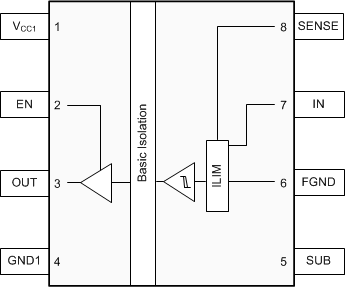TIDUDS9B December 2017 – November 2022
- Description
- Resources
- Features
- Applications
- 5
- 1System Description
-
2System Overview
- 2.1 Block Diagram
- 2.2
Design Considerations
- 2.2.1 Conditions of Use: Assumption
- 2.2.2
Diagnostics Coverage
- 2.2.2.1 Dual-Channel Monitoring
- 2.2.2.2 Checking ISO1211 Functionality With MCU (SIL1)
- 2.2.2.3 Checking TPS22919 Functionality With MCU (SIL1)
- 2.2.2.4 Checking TPS27S100 Functionality With MCU (SIL1)
- 2.2.2.5 Optional Monitoring Using RDY Pin of ISO5452, ISO5852S or UCC21750 Integrated Analog-to-PWM Isolated Sensor
- 2.2.3 Drive State
- 2.3 Highlighted Products
- 2.4 System Design Theory
-
3Hardware, Software, Testing Requirements, and Test Results
- 3.1 Getting Started Hardware
- 3.2 Testing and Results
- 4Design Files
- 5Related Documentation
- 6About the Author
- 7Recognition
- 8Revision History
2.3.1 ISO1211
Figure 2-6 shows the pin diagram of the ISO1211. The ISO1211 devices are isolated, 24- to 60-V digital input receivers These receivers are compliant to IEC 61131-2 Type 1, 2, and 3 characteristics and suitable for programmable logic Controllers (PLCs) and motor-control digital input modules. Unlike traditional optocoupler solutions with discount, impair current-limiting circuit, the ISO121x devices provide a simple, low-power solution with an accurate current limit to enable the design of compact and high-density I/O modules. These devices do not require field-side power.
 Figure 2-6 ISO1211 Pin Diagram
Figure 2-6 ISO1211 Pin Diagram